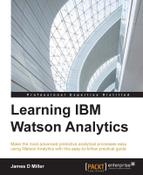Watson (from a strategic perspective) starts with your understanding that as you use and develop the Watson technology within your organization. The knowledge and experience you and your coworkers acquire and/or advance are characterized as your knowledge of Watson or knowledge objects (artifacts or assets created and saved to a Watson collection).
This knowledge can typically be organized into one of five different categories:
- Data interpretation
- Classification or grouping of data
- Data enrichment
- Normalization and modeling
- Collections
Let's see more about these in the next subsections.
The process of understanding the data files you upload to Watson begins with the identification and extraction of certain data points or fields (from a raw data file or data source). Using the Watson Explore feature (or an external tool), you can learn to focus on specific (or default) fields that will help bring explicit meaning to the data, which otherwise might not always be evident. Additional fields may also be (manually) added to your data to expand upon and improve the organizations level of understanding.
You can decide to classify or group together data into interesting sets of corresponding data events before uploading it to Watson. These combined files are those that your organization has discovered through prior explorations or internal knowledge of the data source.
Again, your data files can be enriched through the use of the Watson Explore feature or an external tool using renaming, aggregation, computations (in the form of formula fields) and so on. This can easily extend the helpfulness of data in numerous ways.
You can use external tools to normalize and model your organizations collections of field information, group your sets of associated field values, and add extracted fields (from other data sources). You can tag different fields in your data as the same or perhaps give different fields aliases to make Watson treat them the same.
